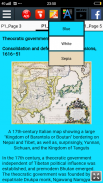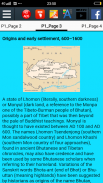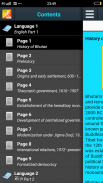










History of Bhutan

คำอธิบายของHistory of Bhutan
Bhutan's early history is steeped in mythology and remains obscure. Some of the structures provide evidence that Bhutan existed as early as 2000 BC. According to a legend it was ruled or controlled by a Cooch-Behar king, Sangaldip, around the 7th century BC,[1] but not much is known prior to the introduction of Tibetan Buddhism in the 9th century, when turmoil in Tibet forced many monks to flee to Bhutan. In the 12th century, the Drukpa Kagyupa school was established and remains the dominant form of Buddhism in Bhutan today. The country's political history is intimately tied to its religious history and relations among the various monastic schools and monasteries.[2]
Bhutan is one of only a few countries which have been independent throughout their history, never conquered, occupied, or governed by an outside power (notwithstanding occasional nominal tributary status). Although there has been speculation that it was under the Kamarupa Kingdom or the Tibetan Empire in the 7th to 9th centuries, firm evidence is lacking. From the time historical records are clear, Bhutan has continuously and successfully defended its sovereignty.[3]
The consolidation of Bhutan occurred in 1616 when Ngawanag Namgyal, a lama from western Tibet known as the Zhabdrung Rinpoche, defeated three Tibetan invasions, subjugated rival religious schools, codified the Tsa Yig, an intricate and comprehensive system of law, and established himself as ruler over a system of ecclesiastical and civil administrators. After his death, infighting and civil war eroded the power of the Zhabdrung for the next 200 years. In 1885 Ugyen Wangchuck was able to consolidate power, and began cultivating closer ties with the British in the subcontinant.[2]
In 1907, Ugyen Wangchuck was elected as the hereditary ruler of Bhutan, crowned on December 17, 1907, and installed as the head of state, the Druk Gyalpo (Dragon King). In 1910, King Ugyen and the British signed the Treaty of Punakha which provided that British India would not interfere in the internal affairs of Bhutan if the country accepted external advice in its external relations. When Ugyen Wangchuck died in 1926, his son Jigme Wangchuck became ruler, and when India gained independence in 1947, the new Indian Government recognized Bhutan as an independent country. In 1949 India and Bhutan signed the Treaty of Peace and Friendship, which provided that India would not interfere in Bhutan's internal affairs, but would guide its foreign policy. Succeeded in 1952 by his son Jigme Dorji Wangchuck, Bhutan began to slowly emerge from its isolation and began a program of planned development. The National Assembly of Bhutan, the Royal Bhutanese Army, and the Royal Court of Justice were established, along with a new code of law.[2] Bhutan became a member of the United Nations in 1971.
In 1972, Jigme Singye Wangchuck ascended the throne at age 16.[4] He emphasized modern education, decentralization of governance, the development of hydroelectricity and tourism and improvements in rural developments. He was perhaps best known internationally for his overarching development philosophy of "gross national happiness." It recognizes that there are many dimensions to development and that economic goals alone are not sufficient. Satisfied with Bhutan's transitioning democratization process, he abdicated in December 2006 rather than wait until the promulgation of the new constitution in 2008. His son, Jigme Khesar Namgyel Wangchuck, became King upon his abdication.[2]
สมัยก่อนประวัติศาสตร์ของภูฏานแพร่หลายในตำนานและยังคงคลุมเครือ บางส่วนของโครงสร้างแสดงหลักฐานว่าภูฏานมีอยู่เป็นช่วงต้นของปี 2000 ปีก่อนคริสตกาล ตามตำนานมันถูกปกครองหรือควบคุมโดยชส์-Behar กษัตริย์ Sangaldip รอบศตวรรษที่ 7 [1] แต่ไม่มากเป็นที่รู้จักกันก่อนที่จะมีการแนะนำของพุทธศาสนาในทิเบตในศตวรรษที่ 9 เมื่อความวุ่นวายในทิเบตบังคับหลาย พระสงฆ์จะหนีไปประเทศภูฏาน ในศตวรรษที่ 12, โรงเรียน Drukpa Kagyupa ก่อตั้งขึ้นและยังคงรูปแบบที่โดดเด่นของพุทธศาสนาในภูฏานวันนี้ ประวัติศาสตร์การเมืองของประเทศที่จะเชื่อมโยงอย่างใกล้ชิดกับประวัติศาสตร์ศาสนาและความสัมพันธ์ระหว่างโรงเรียนวัดต่างๆและพระราชวงศ์. [2]
ภูฏานเป็นเพียงหนึ่งในไม่กี่ประเทศที่ได้รับอิสระตลอดประวัติศาสตร์ของพวกเขาไม่เคยเอาชนะครอบครองหรือควบคุมโดยอำนาจนอก (แม้จะมีสถานะแควน้อยเป็นครั้งคราว) แม้ว่าจะมีการคาดเดาว่ามันอยู่ภายใต้การ Kamarupa ราชอาณาจักรหรือจักรวรรดิทิเบตในวันที่ 7 ถึงศตวรรษที่ 9 หลักฐาน บริษัท ขาด จากเวลาที่บันทึกทางประวัติศาสตร์มีความชัดเจนภูฏานได้อย่างต่อเนื่องและประสบความสำเร็จได้รับการปกป้องอำนาจอธิปไตยของตน. [3]
งบการเงินรวมของภูฏานที่เกิดขึ้นใน 1616 เมื่อ Ngawanag Namgyal, ลามะจากทิเบตตะวันตกที่รู้จักในฐานะ Zhabdrung พอชแพ้สามรุกรานทิเบตปราบปรามโรงเรียนสอนศาสนาคู่แข่งประมวล Tsa Yig, ระบบซับซ้อนและครอบคลุมของกฎหมายและเป็นที่ยอมรับว่าตัวเองเป็นผู้ปกครอง มากกว่าระบบของผู้บริหารคณะสงฆ์และทางแพ่ง หลังจากการตายของเขาแย่งชิงและสงครามกลางเมืองกัดเซาะอำนาจของ Zhabdrung สำหรับ 200 ปีข้างหน้า ในปี 1885 Ugyen Wangchuck ก็สามารถที่จะรวมพลังและเริ่มปลูกฝังความสัมพันธ์ใกล้ชิดกับอังกฤษใน subcontinant ได้. [2]
ในปี 1907, Ugyen Wangchuck ได้รับเลือกเป็นผู้ปกครองทางพันธุกรรมของภูฏานปราบดาภิเษก 17 ธันวาคม 1907 และการติดตั้งเป็นประมุขแห่งรัฐที่ Druk Gyalpo (Dragon King) ในปี 1910 กษัตริย์ Ugyen และอังกฤษลงนามในสนธิสัญญา Punakha ซึ่งมีเงื่อนไขว่าบริติชอินเดียจะไม่เข้าไปยุ่งในกิจการภายในของประเทศภูฏานถ้าประเทศที่ได้รับการยอมรับคำแนะนำจากภายนอกในความสัมพันธ์ภายนอก เมื่อ Ugyen Wangchuck เสียชีวิตในปี 1926 ลูกชายของเขา Jigme Wangchuck กลายเป็นผู้ปกครองและเมื่ออินเดียได้รับเอกราชในปี 1947 รัฐบาลอินเดียใหม่ได้รับการยอมรับภูฏานเป็นประเทศเอกราช ในปี 1949 อินเดียและภูฏานลงนามในสนธิสัญญาสันติภาพและมิตรภาพซึ่งระบุว่าอินเดียจะไม่เข้าไปยุ่งในกิจการภายในของภูฏาน แต่จะเป็นแนวทางในการดำเนินนโยบายต่างประเทศของตน ประสบความสำเร็จในปี 1952 โดยลูกชายของเขา Jigme Dorji Wangchuck ภูฏานเริ่มที่จะค่อย ๆ โผล่ออกมาจากการแยกและเริ่มโปรแกรมของการพัฒนาวางแผน สมัชชาแห่งชาติของภูฏานภูฏานกองทัพหลวงและพระราชศาลยุติธรรมถูกจัดตั้งขึ้นพร้อมกับรหัสใหม่ของกฎหมาย. [2] ภูฏานเป็นสมาชิกของสหประชาชาติในปี 1971
ในปี 1972 สมเด็จพระราชาธิบดีจิกมีซิงเยวังชุกเสด็จขึ้นครองราชย์เมื่ออายุ 16 [4] เขาเน้นการศึกษาที่ทันสมัย, การกระจายอำนาจของการกำกับดูแลการพัฒนาของ hydroelectricity และการท่องเที่ยวและการปรับปรุงในการพัฒนาชนบท บางทีอาจจะดีที่สุดที่เขาเป็นที่รู้จักในระดับสากลสำหรับปรัชญาการพัฒนาของเขาครอบคลุมของ "ความสุขมวลรวมประชาชาติ". ได้ตระหนักว่ามีหลายมิติไปสู่การพัฒนาและเป้าหมายทางเศรษฐกิจเพียงอย่างเดียวไม่เพียงพอ พอใจกับกระบวนการประชาธิปไตยเปลี่ยนภูฏานเขาสละราชสมบัติในธันวาคม 2006 แทนที่จะรอจนกว่าจะประกาศใช้รัฐธรรมนูญใหม่ในปี 2008 ลูกชายของเขาสมเด็จพระราชาธิบดีจิกมีเคเซอร์นัมเกลวังชุกกลายเป็นกษัตริย์เมื่อการสละราชสมบัติของเขา. [2]
























